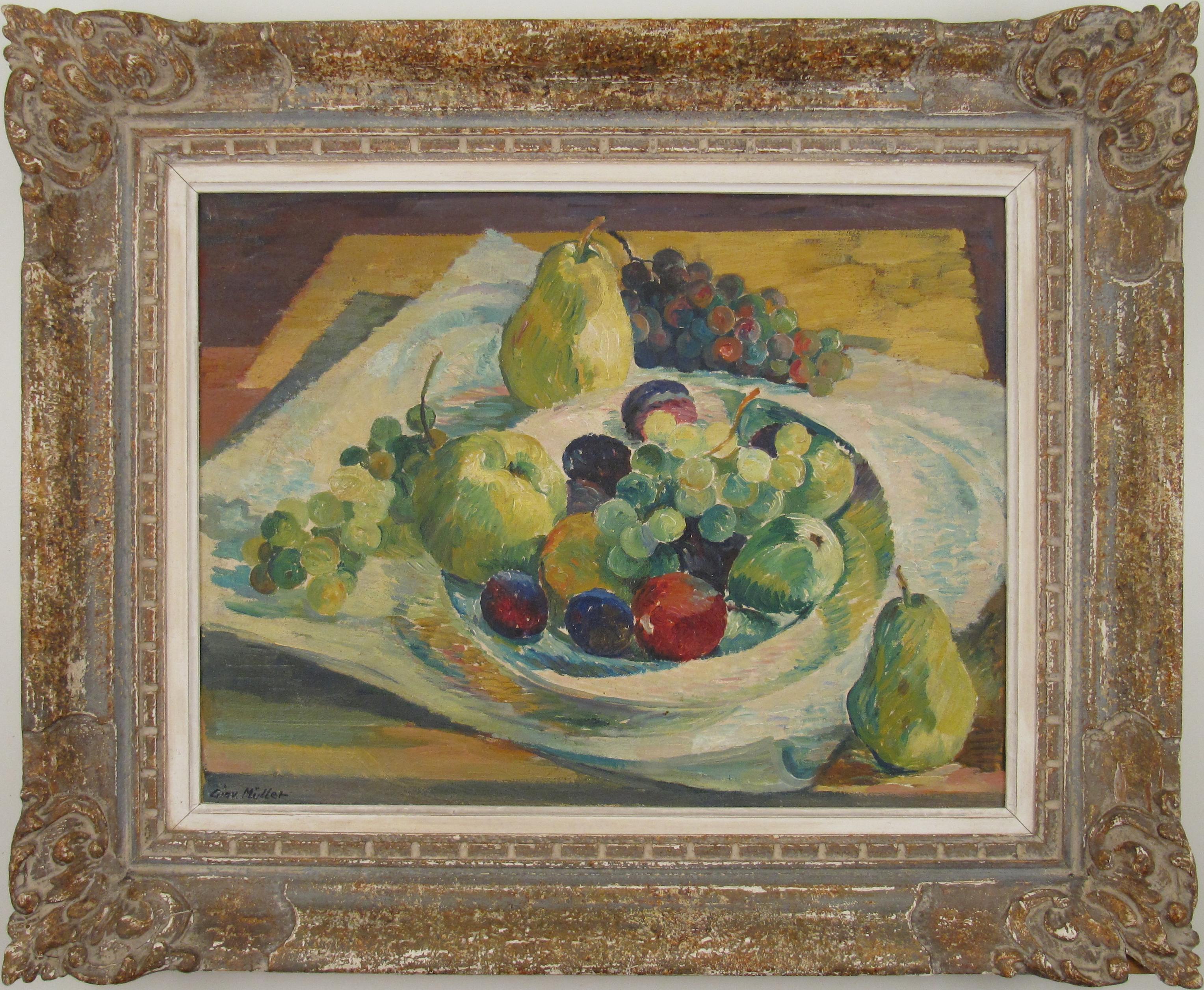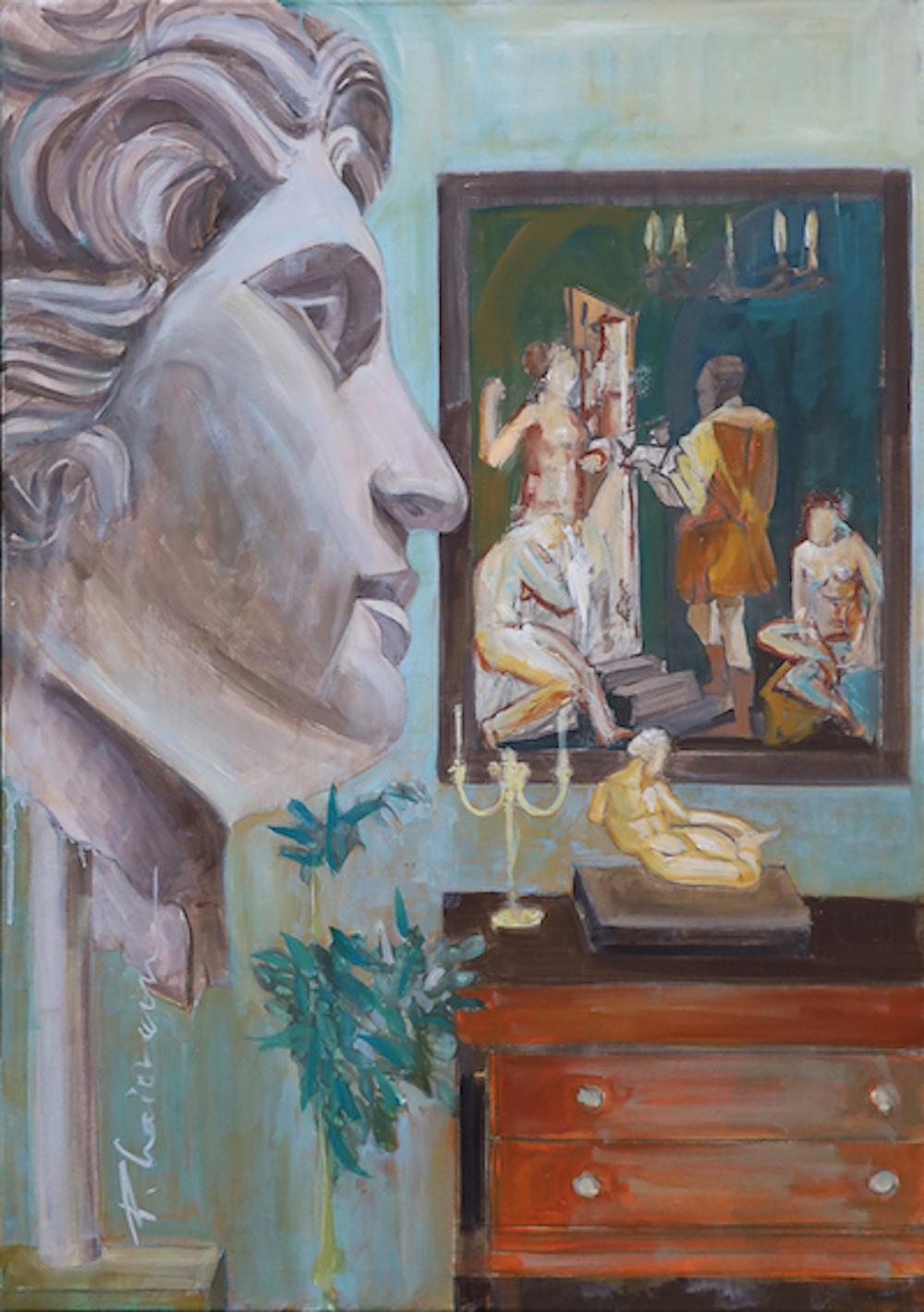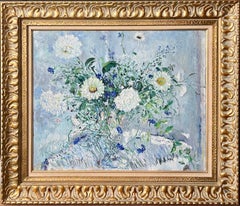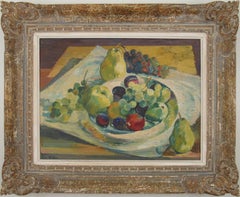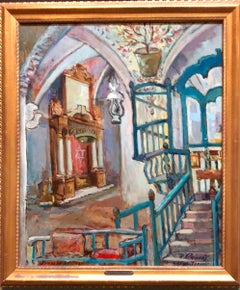
French Israeli Judaica Oil painting Old Synagogue Interior in Safed Israel
View Similar Items
Want more images or videos?
Request additional images or videos from the seller
1 of 12
Raphael PricertFrench Israeli Judaica Oil painting Old Synagogue Interior in Safed Israel1956
1956
About the Item
- Creator:Raphael Pricert (French)
- Creation Year:1956
- Dimensions:Height: 25 in (63.5 cm)Width: 21.5 in (54.61 cm)
- Medium:
- Movement & Style:
- Period:
- Condition:frame has minor wear, rubbing to gilding size includes frame.
- Gallery Location:Surfside, FL
- Reference Number:1stDibs: LU38213152392
About the Seller
4.9
Platinum Seller
These expertly vetted sellers are 1stDibs' most experienced sellers and are rated highest by our customers.
Established in 1995
1stDibs seller since 2014
1,549 sales on 1stDibs
Typical response time: 1 hour
More From This SellerView All
- Polish French Fauvist Judaica Oil Painting Rabbi at PrayerBy Frederick B. SergerLocated in Surfside, FLGenre: Impressionist Subject: People Medium: Oil Surface: Panel Frederick Serger (given name Frederick Bedrick Sinaberger) was born in 1889 to a family of Jewish manufacturers in the village of Ivancice near Brno Moravia, a province of Czechoslovakia. Showing artistic talent at a young age, he attended art schools in Brno, Vienna, and Munich. During World War I, Serger joined the Austrian Army...Category
1940s Fauvist Figurative Paintings
MaterialsCanvas, Oil
- Bold Folk Art Modernist Floral Bouquet Oil Painting Flowers in Vase Gilt FrameBy Samuel RothbortLocated in Surfside, FLSAMUEL ROTHBORT (Russian-American, 1882-1971), still life with wild flowers, oil on canvas board, signed lower left. Framed 25.5 X 30, board 18.5 X 23 Samuel Rothbort (Russian American Jewish folk artist 1881-1972) was born in the small town, shtetl of Wolkovisk in the Russian Woodlands.During his youth he worked as a cantor and traveled to various towns and villages, gaining many impressions of life in that era. Poverty as well as the political unrest of the times led to his immigration to America in 1904. Upon arrival in America, Samuel Rothbort worked as a laborer and muralist eventually giving that up to become a watchman of newly built homes. While on duty he began molding figures in clay and upon the advice and encouragement of his employer and colleagues he began to take his artistic talents more seriously and pursued this endeavor. Rothbort therefore began doing free-hand painting, murals on walls and ceilings for private homes and commercial establishments. In 1909 he met and married Rose Kravitz, which marked the start of his career as an artist. Well known for his scenes of New York City life, executed in heavy impasto. Rothbort exhibited from the 1920s-60s, at the Salons of America, Pratt Institute, Brooklyn Museum, and a gallery at Rockefeller Center; however, he refused to sell his work, and in 1948, opened the Rothbort Home Museum of Direct Art, in his studio-home. Samuel Rothbort was a self taught, naive, outsider artist painting every subject in his own folk art impressionistic style. His artistic range was broad and he never stopped creating. He was fascinated with nature and his works are filled with his delightful perceptions of his surroundings. Rothbort worked in oil, watercolor, and pen & ink. In the years of the depression there was little money, Rothbort could not afford paint or canvas. It was there that he began carving wood and stone using found materials like driftwood, rails, and old fence posts. Rothbort entered the art world and spent much of his life in pursuit of modernist painting and sculpture. He was a member the Society of Independent artists, the Salons of America, the People's Art Guild, and the Brooklyn Society of Artists. During the 1920's and early 1930's , Samuel Rothbort was regularly represented in exhibitions organized by The Brooklyn Museum of Art. Through the 1930's , Rothbort exhibited his watercolors and sculptures at Grant Studios in Brooklyn. In 1940, he began a 28 year relationship with the Barzansky Gallery on Madison Avenue in New York City exhibiting oils, watercolors, and sculpture in individual and group shows. From 1915 through the 1960's, he was represented by many commercial galleries. Hamilton Easter Field, artist, publisher and founder of the Brooklyn Society of Artists was an early supporter of Rothbort's artwork and helped further his career. Rothbort received much recognition for his naive folk art paintings...Category
20th Century Post-Impressionist Interior Paintings
MaterialsOil
- Wisdom of King Solomon Rare Biblical Hungarian Judaica Oil PaintingBy Anton PeczelyLocated in Surfside, FLRare Pre World War II (Pre Holocaust) Judaica Art. European Judaic art from this period is exceedingly rare. Péczely Antal Anton 1891 - 1963 Known for his Jewish genre scenes, Chess scenes and other early 20th Century salon style paintings. In the tradition of Moritz Oppenheim...Category
Early 20th Century Post-Impressionist Figurative Paintings
MaterialsOil, Board
- Blessing of the Tzadik (Rebbe) Rare Hungarian Judaica Oil PaintingBy Anton PeczelyLocated in Surfside, FLRare Pre World War II (Pre Holocaust) Judaica Art. European Judaic art from this period is exceedingly rare. Péczely Antal Anton 1891 - 1963 Known for his Jewish genre scenes, Chess scenes and other early 20th Century salon style paintings. In the tradition of Moritz Oppenheim...Category
Early 20th Century Post-Impressionist Figurative Paintings
MaterialsOil, Board
- French Post Impressionist Oil Painting Floral Roses, Vase Gaston Sebire FlowersBy Gaston SebireLocated in Surfside, FLLes Roses Mixed bouquet of roses, Oil painting PROVENANCE: Purchased at Findlay Galleries in Chicago, Illinois late 1960’s bears their label verso and has their original price tag ...Category
1960s Post-Impressionist Still-life Paintings
MaterialsCanvas, Oil
- Rare French, Paris 1935 Judaica Oil Painting Rabbis Studying S. FleischmanLocated in Surfside, FLRare Judaica Art. Jewish genre scene. In the tradition of Moritz Oppenheim, Isidor Kauffman and Maurycy Gottlieb and later of Tully Filmus, Zalman Kleinman and Itshak Holtz the artist captures this Jewish scene with a particular sensitivity. Part of the Ecole De Paris The term "School of Paris" was used in 1925 by André Warnod (fr) to refer to the many foreign-born artists who had migrated to Paris. School of Paris artists were progressively marginalized. Beginning in 1935 art publications no longer wrote about Marc Chagall, just magazines for Jewish audiences, and by June 1940 when the Vichy government took power, School of Paris artists could no longer exhibit in Paris at all. The artists working in Paris between World War I and World War II experimented with various styles including Cubism, Orphism, Surrealism and Dada. Foreign and French artists working in Paris included Jean Arp, Joan Miró, Constantin Brâncuși, Raoul Dufy, Tsuguharu Foujita, artists from Belarus like Michel Kikoine, Pinchus Kremegne, and Jacques Lipchitz, the Polish artist Marek Szwarc and others such as Russian-born prince Alexis Arapoff. A significant subset, the Jewish artists, came to be known as the Jewish School of Paris or the School of Montparnasse. The "core members were almost all Jews, and the resentment expressed toward them by French critics in the 1930s was unquestionably fueled by anti-Semitism." One account points to the 1924 Salon des Indépendants, which decided to separate the works of French-born artists from those by immigrants; in response critic Roger Allard (fr) referred to them as the School of Paris. Jewish members of the group included Emmanuel Mané-Katz, Chaim Soutine, Adolphe Féder, Chagall, Moïse Kisling, Maxa Nordau...Category
Mid-20th Century Post-Impressionist Figurative Paintings
MaterialsOil, Board
You May Also Like
- Mid 20thCentury Post Impressionist 'Mending Garments by Lamp Light' oil c1930'sLocated in Frome, SomersetA fine mid 20th century post impressionist oil of a young woman sewing by lamplight circa 1960's oil on canvas 46cmx 70cm good gallery frame 63cmx 88cm Very atmospheric light effect painted in expressive colourfield palette creating a soft diffused atmosphere under the old lamp...Category
1960s Post-Impressionist Interior Paintings
MaterialsOil
$766 Sale Price36% Off - Giovanni Müller 1890-1970 Impressionist Still Life Oil Painting Switzerland 1930By Giovanni MüllerLocated in Meinisberg, CHGiovanni Müller (Swiss, * 25.4.1890 Krinau, † 11.1.1970 Zürich) Still Life of Fruit in a Bowl • C. 1930 • Oil on canvas, ca. 39 x 51 cm • Frame, ca. ...Category
1930s Post-Impressionist Still-life Paintings
MaterialsCanvas, Oil
- Figurative portrait interior oil painting Women and child portrait paintingLocated in AIGNAN, FRAntique post impressionist Art Deco figurative oil painting by French artist Bernard Py. This large size animated interior painting of two wom...Category
1920s Post-Impressionist Figurative Paintings
MaterialsOil
- Looking at the WorldBy Paula CraioveanuLocated in Santa Monica, CAOil on canvasCategory
21st Century and Contemporary Fauvist Interior Paintings
MaterialsCanvas, Oil
$3,040 Sale Price20% Off - Interior with window and still life Spain oil on cardboard painting spanishBy Rafael Duran BenetLocated in Barcelona, BarcelonaRafael Duran Benet (1931-2015) - Interior with window and still life - Oil on cardboard Oil measurements 100x70 cm. Frameless. Rafael Duran Benet (Terrassa, 1931 - Barcelona, 2015) ...Category
Early 2000s Post-Impressionist Still-life Paintings
MaterialsOil, Cardboard
- The painter and the Model oil on canvas painting fauvism nudeBy Jordi CurosLocated in Barcelona, BarcelonaJordi Curós Ventura (1930-2007) - the painter and the Model - Oil on canvas. Work measurements 61x46 cm. Frameless. Jordi Curós Ventura (Olot, Girona, March 4, 1930) is a Spanish pa...Category
1970s Fauvist Nude Paintings
MaterialsCanvas, Oil
$633 Sale Price27% Off
